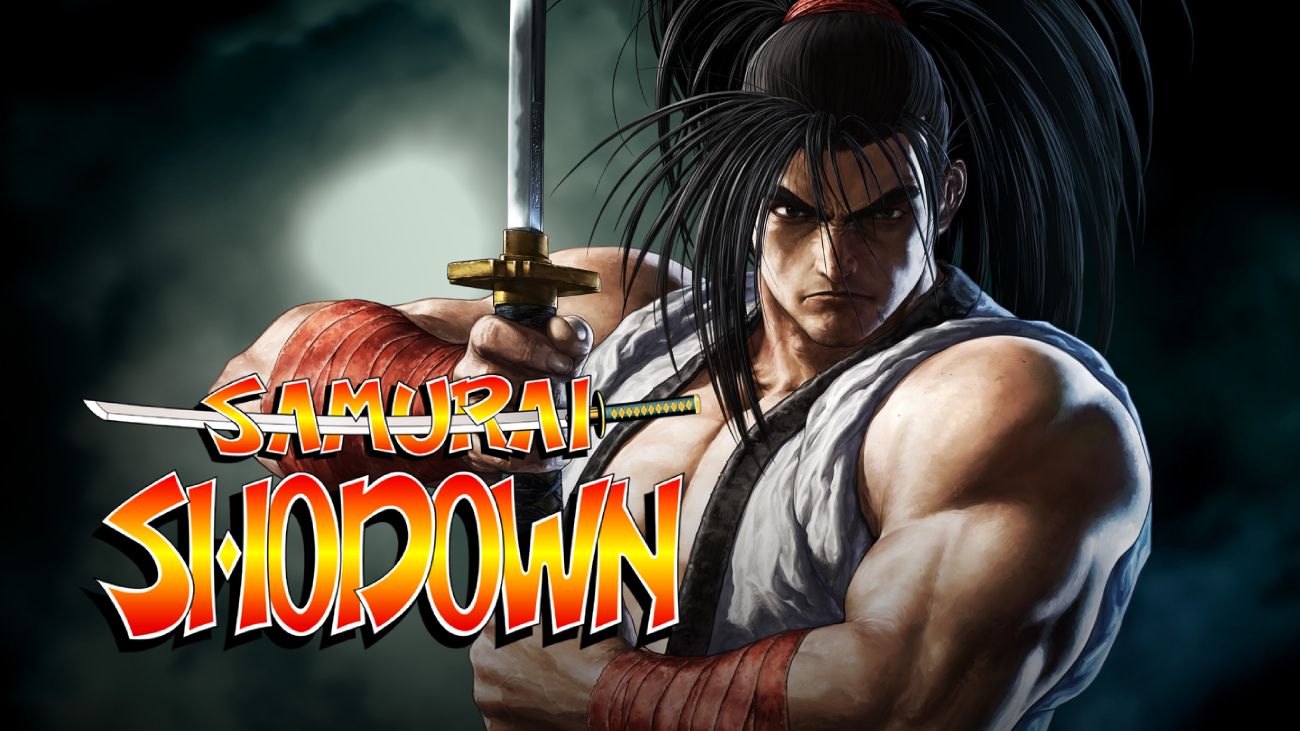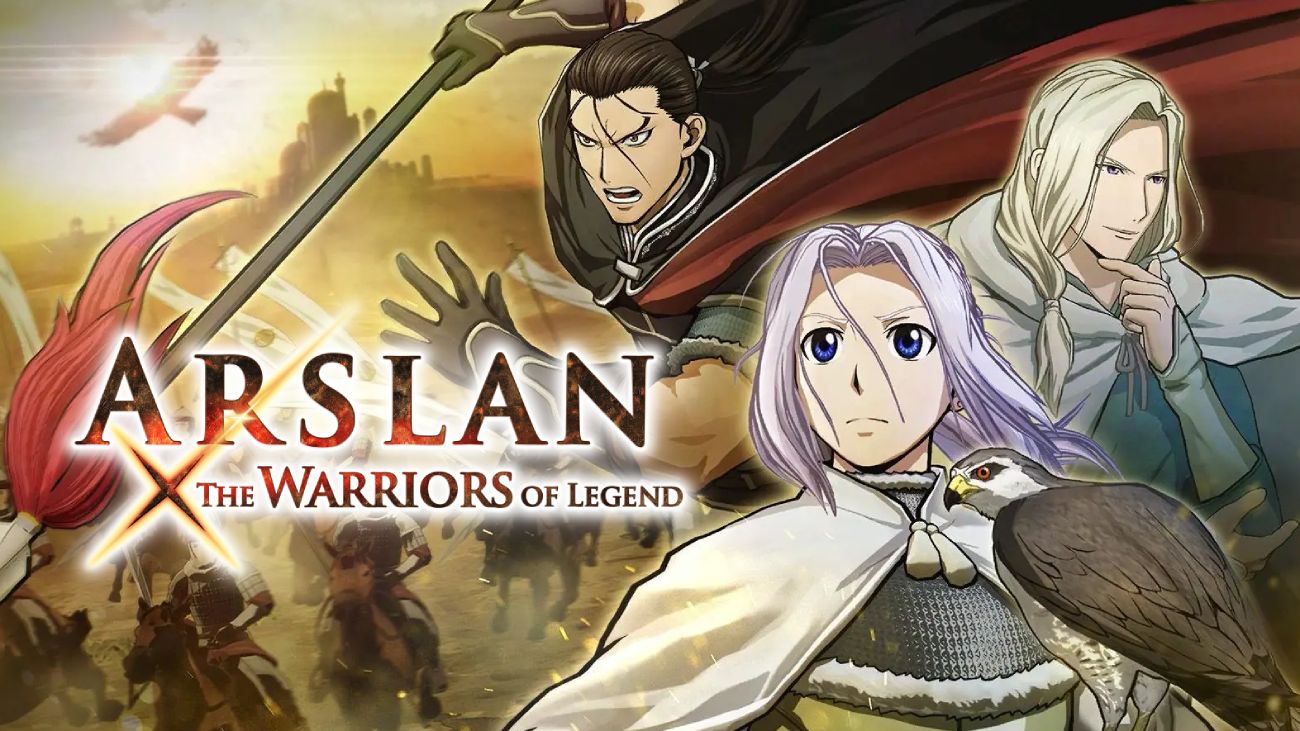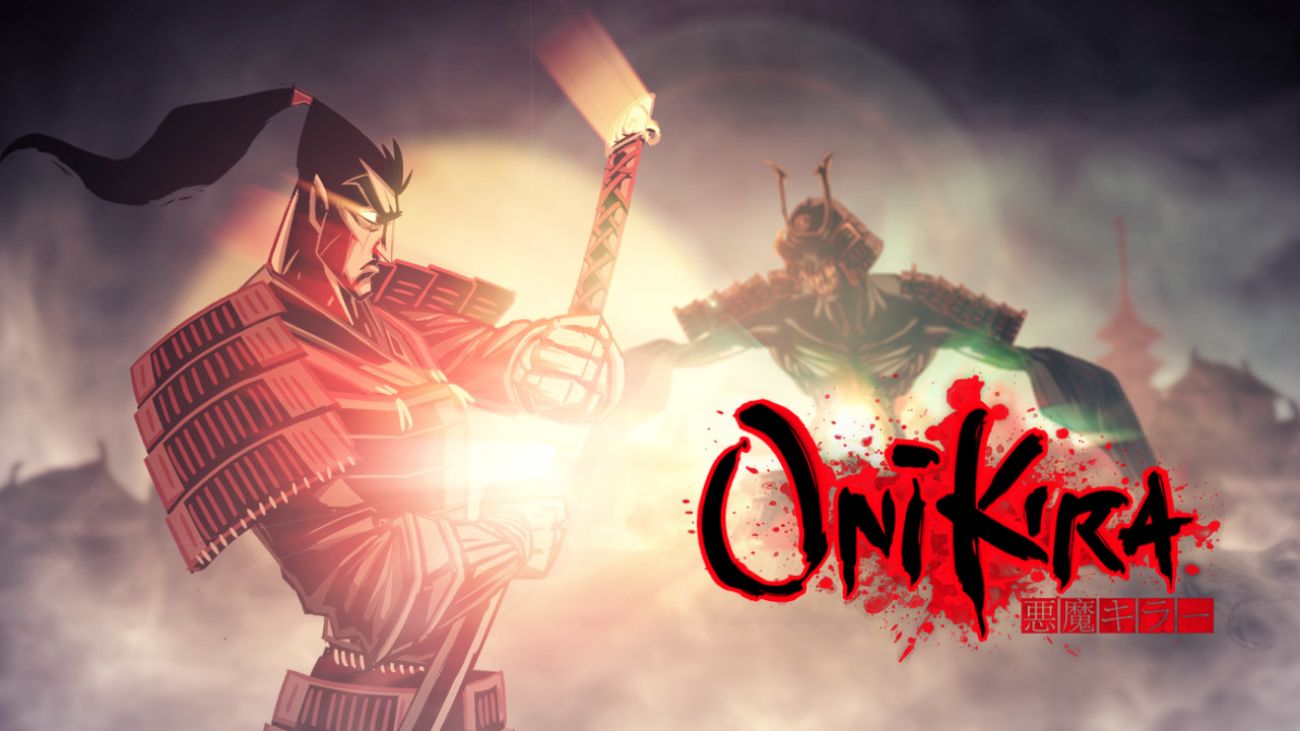Ōtani Yoshitsugu (大谷吉継, 1558 or 1565 – October 21, 1600) was a Japanese samurai from the Sengoku period to the Azuchi-Momoyama period. He was also known by his judicial title of Deputy Minister of Justice or Gyōbu-shōyū (刑部少輔). He was born in 1558, the son of a servant of Ōtomo Sōrin or Rokkaku Yoshikata. He became one of Toyotomi Hideyoshi’s disciples. He took part in the Odawara campaign and the Toyotomi Korean campaign.
A Bond of Friendship
Ōtani Yoshitsugu is well known in Japan for two main aspects: his leprosy and his friendship with Ishida Mitsunari. He was supposed to put friendship first (although it’s obviously difficult to determine such a subjective matter), and it was perhaps in Korea that Ishida and Ōtani, working together, formed their legendary friendship.

There’s even an anecdote linked to this friendship: one day, at a secret tea party, all the guests passed around a cup of tea. When Ōtani Yoshitsugu took a sip, pus from his face fell into the cup. Yoshitsugu noticed, but too late: the cup was already being passed from hand to hand. People taking sips after that had horrified expressions on their faces, but when it was Mitsunari’s turn, he calmly drank all the remaining tea, pus and all.
A Mysterious Past
In case Yoshitsugu was born during Yoshifusa’s reign, there’s a popular story about the origin of his childhood name, Keimatsu (桂松 or 慶松). Before his son was born, Yoshifusa lamented his lot with his children and wished for a male heir.
One day, his wife decided to pray before a shrine dedicated to Hachiman Daibosetsu in their homeland. As she expressed her desire to have a child, a pine tree was cut down in front of the shrine and fell in front of her. He plucked some of the fallen branches and ate them for good luck. When she gave birth, Yoshifusa was overjoyed to see her first child. Grateful for the god’s response, he named his son after the plant.

His first legal pseudonym was Heima (平馬), given to him when he first served under Hideyoshi. He received the name for his cavalry leadership at Harima or in recognition of his service at the siege of Miki. A few years later, temple impressions associated him with the pseudonym Kinosuke or Norinosuke (紀之介). It has also been suggested that he changed his name to Ōtani Gyōbu (大谷刑部). Gyōbu would have been offered as a respectful link to the Genji family or in honor of Yoshitsugu’s superior rank at the time.
When Yoshitsugu fell ill with leprosy, it was commonly said that he looked terribly pale, earning him the nickname “White Face” (白頭). Legends claim that this name could also be due to the fact that he covered his face with a white mask, a typical outfit when suffering from the disease.
It is said that, before the battle of Sekigahara, Yoshitsugu made several attempts to persuade Mitsunari of the futility of his actions. However, seeing the firmness of his friend’s convictions, Yoshitsugu joined his cause after thinking about it for several days. By this time, Yoshitsugu’s health was deteriorating, leaving him almost blind. He couldn’t stand up, let alone fight. He was carried to the battlefield in a palanquin.
A Fateful Decision
Yoshitsugu led around 600 men, with another 4,000 or so under the command of Toda Shigemasa, Hiratsuka Tamehiro, Ōtani Yoshikatsu (his son), and Kinoshita Yoritsugu. As the battle continued, Kobayakawa Hideaki, who was above Yoshitsugu on Mount Matsuo, would not budge, despite repeated calls from Ishida Mitsunari.

Yoshitsugu suspected something, so he ordered his troops to position themselves in preparation for a possible attack from their flanks. His hunch was correct, for after an alleged volley of booster cannon fire from Ieyasu’s position, Kobayakawa Hideaki and his troops rushed toward Yoshitsugu’s position. This decision was immediately followed by Akaza Naoyasu, Ogawa Suketada, Kutsuki Mototsuna, and Wakizaka Yasuharu, a total of over 20,000 soldiers.
Yoshitsugu’s troops counter-attacked, at one point even pushing Kobayakawa’s troops halfway up the mountain, but in the end, the sheer number of soldiers took its toll. Meanwhile, Yoshitsugu, unable to see, repeatedly asked one of his servants, Yuasa Gosuke, “Is he lost?” When the latter finally answered in the affirmative, Yoshitsugu asked him to cut off his head. He was then beheaded by his servant, who also committed seppuku.
A Figure of Legend
Ōtani Yoshitsugu has been romanticized in poetry and fiction as Ishida Mitsunari’s heroic and talented friend since the Edo period. They are said to have been good friends since their early days working with Toyotomi Hideyoshi, each respecting the judgment and character of the other.
A special event the most famous of which occurred during a tea ceremony at Osaka Castle in 1587. A sickly Yoshitsugu drank from the bowl of tea traditionally distributed to participants, but left an embarrassing pus stain after his bite.
Remaining faithful to the ceremony, he was forced to pass it on to others. The participants avoided their traditional drink and respectfully moved it along the line. When it came time for Mitsunari, he drank the entire contents without hesitation and commented that the tea was magnificently delicious.
Yoshitsugu was moved by his friend’s gesture, which is said to have led to his determination to fight for the Western army. There is also a legend that the two men became romantically involved because of their close ties, which sometimes began because of this event.
Although the tea ceremony incident has been recorded by people who actually lived during this period (including Kamiya Sōtan and Tsuda Sōgyū), the subject of their true friendship is a matter of speculation. To be more precise, Yoshitsugu himself is under the gaze of skepticism.
Edo period histories consider Yoshitsugu an honorable and talented vassal from his youth, but nothing in the historical record offers details to back up his claims. His father is said to have been Ōtani Yoshifusa (vassal of Hideyoshi) or Ōtani Moriharu (vassal of the Ōtomo family) since they both shared the same surname.
Both men are of unknown origin and there is little recorded about them beyond a few notes and their names. It is often said that he was born in the province of Ōmi; His mother was one of the servants of the Kōdai-In and so Yoshitsugu became Hideyoshi’s favorite. However, if we believe her father was Moriharu, this completely distorts the story, as Yoshitsugu would also have joined Hideyoshi after leaving the Ōtomo family when he was in his twenties. As little is known about the Ōtani clans to fully verify the stories, Yoshitsugu’s first encounter with the Taikō is a mystery.
The unknown parts of his life create a twenty- or thirty-year gap often filled with stories and rumors. Among those in doubt is their connection to Mitsunari, as legends proclaim that they knew each other since they served Hideyoshi in their youth. Their age contradicts the tales created for their relationship (romanticized as having occurred because of their close age) and adds more mystery to Yoshitsugu.
The contradictions became so confusing that a rather radical theory emerged among a small segment of believers about their friendship. This story maintains that Yoshitsugu had died of his illness less than a year after contracting it and that Sekigahara’s Yoshitsugu was, in fact, a seriously ill Hideyoshi in disguise.
While this is an interesting concept, it has to prove that Hideyoshi somehow survived his historically accepted death date and further fuels the fire of debate. In any case, speculation as to whether the two men really considered themselves friends continues to this day.
Ōtani Yoshitsugu Family
It’s not known whether he had an official wife, but he was supposed to be the father of three sons and a daughter. His second son died with him at Sekigahara, while his other two sons joined the Toyotomi family at Osaka Castle or lived in isolation after the wars.
Yoshitsugu’s daughter, Chikurin-in, was the wife of Sanada Yukimura and the mother of his two heirs: Sanada Daisuke (Yukimasa) and Sanada Daihachi (Morinobu). A folk tale claims that Yoshitsugu had a concubine before Sekigahara, who went mad with grief after his death.

Rise to Power and Service to Hideyoshi
Of unknown origin. Under Hideyoshi, Yoshitsugu became a kōshō, who took charge of secretarial affairs, notably acting as a human shield to protect his lord at the risk of losing his life (for this reason, the kosho not only had to be erudite and have impeccable manners, but also skilled in the military arts).
Yoshitsugu could have entered Hideyoshi’s service as a low-ranking kōshō or become Mitsunari’s yoriki in the mid-to-late 1570s (either in his late teens or mid-twenties). Several stories claim that his intelligence and charm had won him many friends, but the legitimacy of these claims is still debated.
His early achievements within the Hashiba family are not known, but most sources maintain that he was among the 700 or so-named individuals who allied themselves with Hideyoshi after the Honnōji incident. He joined forces with Katō Toranosuke, Fukushima Ichimatsu, and other kōshō to seize Nagahama Castle from Shibata Katsutoyo, the nephew of Shibata Katsuie. It has been romanticized that Hideyoshi said the following about Yoshit: Sugu at the time: “Give me a million soldiers and I’d love to see him lead them.”
Yoshitsugu is said to have participated in Toyotomi’s ranks at the start of the Battle of Shizugatake. What he did, if anything, is scattered among legends and folklore. One account claims that it was he who used his wits to convince Katsutoyo to surrender before the battle.

Another account describes him as a brave warrior on the front line, performing many feats with his magnificent spear. The Hitosuyanagi Kaki is famous for stating that Hideyoshi enormously praised Yoshitsugu and Mitsunari for the battle, declaring in particular for Yoshitsugu: “Ōtani Keimatsu was the participant who was excellent from the first blow.” However, this statement does not appear in other historical texts, so the quote may be completely fictitious.
What is certain about Yoshitsugu’s service is that he was appointed Gyōbu-shōyū (a minor minister of Justice) in 1585. At this time, Yoshitsugu would have been accepted as one of the elite members of Hideyoshi’s inner circle.
According to Uno Mondo Nikki, a document written as a secretarial file for Kennyo, Yoshitsugu, and Mitsunari were among the men who accompanied Hideyoshi to Arima Onsen in September 1585 and bathed in the same pool as him. During this time, Yoshitsugu is said to have fallen seriously ill. There’s a particularly famous story to explain why he might have suffered an illness.
In 1586, while he was in Osaka, a mutiny broke out, and Yoshitsugu went to quell it personally. He killed 1,000 men for Hideyoshi’s pleasure, but the blood splashed on him caused an infection. The Uno Mondo Nikki and the Tamon-In Nikki, considered to be the diary of the monk Eishūn, give a milder version of Yoshitsugu’s illness.
They report rumors that Yoshitsugu sought to receive blood from living beings in the city, a method supposed to cure illness. It was also said that he had been genuinely ill since Shizugatake, but his symptoms only became apparent then. His illness has not been described in detail in historical documents, but people generally think he suffered from leprosy (due to tales from the Edo period) or syphilis (an alternative explanation due to the involvement of bodily fluids).
A Divided Path
From here, Yoshitsugu’s story is divided into two main stories. The Saifuku-ji Enkinsei, a supposed historical text currently undergoing critical analysis of its authenticity, claims that Yoshitsugu accompanied Ishida Mitsunari to the Kyūshū campaign in 1587 and helped him lead 12,000 soldiers without major difficulties. As a reward, Yoshitsugu received 50,000 koku and became lord of Tsuruga Castle. As local magistrate, he divided 10,000 koku among the Toyotomi vassals in his region.
In 1590, he accompanied Mitsunari to the Odawara campaign and was also present at Oshi Castle, although details of his activities in both conflicts are not clearly mentioned. When Hideyoshi ordered a new crackdown on Kii province, Yoshitsugu was one of the men who took part and brought about Akita Sanesue’s defeat. He is also credited with accompanying Mitsunari on several riots, helping to establish Fushimi Castle as a fortress, and taking part in the Korean campaign (1592-1598).
Yoshitsugu returned from Korea a celebrated hero and was welcomed by Hideyoshi at Osaka Castle. He was invited to share tea with Hideyoshi at a banquet. As the festivities dragged on between the two, Yoshitsugu’s nasal mucus accidentally seeped into his tea bowl. Yoshitsugu was about to leave embarrassed until Hideyoshi noticed. Expressing that his throat was dry, he asked Yoshitsugu to hand him the same bowl of tea with the snot. When it was given to him, Hideyoshi affirmed that the liquid would be exquisite in his vassal’s capable hands and drank it as if there were nothing wrong with it. Crying for the first time in his adult life, Yoshitsugu then swore allegiance to the Toyotomi family in gratitude.
The secondary story, less popular but reasonable, shows Yoshitsugu bedridden by his illness. The Rokuon-In Chiroku, considered to be the diary of the head monk of Kinkaku-ji during this period, states that his illness had reached its most serious stages and that Yoshitsugu had not left the immediate vicinity of his residence for five years. or six years.
His body couldn’t withstand arduous travel, which meant he couldn’t sail abroad or take part in arduous campaigns. Despite what the above account says, he did not attend post-Korean campaign festivities, such as Daigo’s flower viewing, due to his weakened state. That’s why ice that he left his house once in 1598 to celebrate Hideyori’s presentation to the court, and that a frail Hideyoshi gave him snacks for his illness.
The Road to Sekigahara
After Hideyoshi’s death, Yoshitsugu considered allying himself with Tokugawa Ieyasu in the Ietada Nikki. In 1599, Yoshitsugu gathered his men and headed for Tarui Castle with Tokugawa troops. According to the Keicho Kenmonshu, Mitsunari was at Sawayama Castle and invited Yoshitsugu to his kingdom.

Although blind from illness when he entered the gates, Yoshitsugu was horrified to find armed soldiers waiting for him, and developed a silent grudge against Mitsunari. Undeterred, Mitsunari introduced him to his vassal, Shima Kiyooki. Kiyooki changed Yoshitsugu’s perception of the Western army, but he wanted to stay in Ieyasu’s ranks because he thought Mitsunari couldn’t win.
However, for some reason, Mitsunari managed to convince Yoshitsugu to defect and join the Western army. Legend has it that Ieyasu knew of Yoshitsugu’s talent and was prepared to offer 12,000 koku for his services. Hearing of Yoshitsugu’s sudden change of allegiance truly surprised him.
As to why Yoshitsugu changed his mind, the reasons remain an enigma to this day. No one really knows why Yoshitsugu did this, as there is little record of it. There are many stories about why he might have done it, but they lack real support due to the absence of historical evidence.
The popular scene developed during the Edo period, claiming that they got together out of friendship. In this interpretation, Yoshitsugu thought only of joining Ieyasu, and Mitsunari asked him three times to join him. Even though Yoshitsugu knew it was a failed cause, he couldn’t abandon his ties with his friend and merged his forces in the Western army with his sons.
Another story tells of Sanada Masayuki’s wife being held hostage by the Western army. Linked to the Sanada family by his daughter’s marriage, he was forced to rely on the opposition for his safety. Another fable recounts that he had a conflict with Ukita Hideie and joined Ieyasu just to avoid it.
Mitsunari learned of this and mediated between the two parties, eventually convincing Yoshitsugu to stay. Whatever the reason, Yoshitsugu now fought for the Toyotomi family. Rumor has it that he misinformed Maeda Toshinaga about the dangers of Asainawate, leading to the battle with defender Niwa Nagashige (however, it has been speculated that this was also another lie linked to him).
His other activities prior to the Battle of Sekigahara are unclear, but he is said to have suggested to Mitsunari that he move his main base the night before the conflict. Yoshitsugu leads an army of 6,500 men into battle, commands 600 men, and has three subordinates: Hitatsuka Tamehiro with 900 men, his son, Ōtani Yoshikatsu, with around 2,500 men, and Kinoshita Yoritsugu with 1,000 men. Another daimyo under Yoshitsugu’s command: Toda Katsushige with 1,500 soldiers.
The Battle of Sekigahara and a Tragic End

According to the Sekigahara Gunki Taisei, Yoshitsugu was aware of Kobayakawa Hideaki’s treason plans, but was unable to prevent them. He repositioned his army to monitor Kobayakawa’s movements, ostensibly because he didn’t want his allies to suffer too much from the announced betrayal.
Once Kobayakawa’s 15,000-strong army had descended the mountain to the west, Yoshitsugu’s army acted as a shield for their advance Armed with a competent elite army, it would appear that Yoshitsugu had the advantage for the first engagement (Kobayakawa’s army had 370 killed or wounded while Ōtani’s had suffered 180 or more casualties), however, he was already engaging the eastern forces under his command. of Tōdō Takatora when Kobayakawa charged. Tōdō Takatora’s army attacks Yoshitsugu’s flank. Ietada Nikki registers Kiyooki’s fourth son, Shima Kiyomasa, in Yoshitsugu’s ranks and attempts to kill Takatora with a single blow.
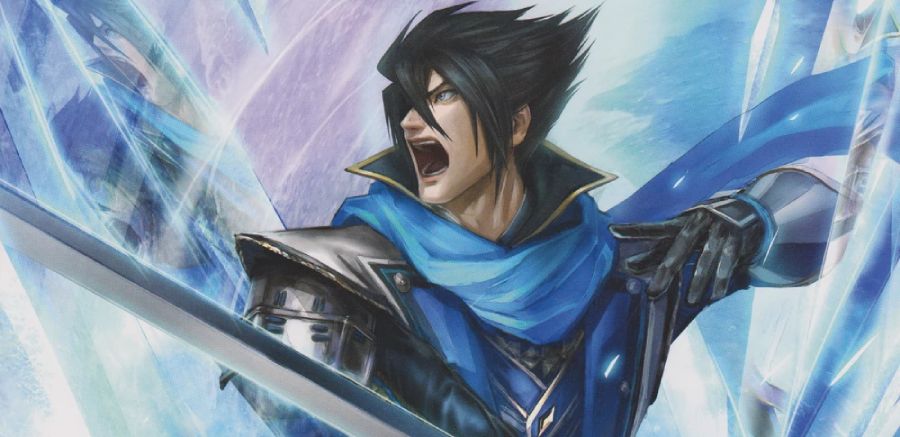
However, Kiyomasa was shot and killed by an Eastern general named Takagi Heizaburō. Kiyomasa’s fate reflected the situation on Ōtani’s flanks, as his defenses were crippled on all sides due to the overwhelming number of troops. Completely defeated, Yoshitsugu lost his footing and committed suicide. Assuming he was known as Yoshitaka, a tombstone has been placed for him at Sekigahara.
There are two famous accounts of his final moments, although both are considered of dubious authenticity. In the Keicho Nenjuki, Yoshitsugu was unable to move about on his own, and gave orders to his subordinates via a palanquin.
As the battle against Kobayakawa continued, he ordered his close servant, Yuasa Gosuke, to inform him when he The battle was lost. Repeatedly, cries of defeat echoed throughout Yoshitsugu’s camp, but Gosuke continued to insist that the situation could still be reversed.
Once Gosuke admitted that they were heading for defeat, Yoshitsugu pulled his body half out of his vehicle and cut off his head. Gosuke had promised his lord earlier that he would hide his lord’s head so the enemy wouldn’t discover it, but he died in battle trying to escape Takatora’s army. The same book also claims that Yoshitsugu rode a horse and ordered it to be sliced through the torso once Gosuke had given the order.

The other story has its roots in the mountain of folklore that developed during the Edo period. It was Tamehiro who informed Yoshitsugu of the bad news and deeply regretted not being able to stop Kobayakawa. In his remorse, he sang a poem to encourage his lord to commit suicide, which could be translated as “so that I may give up your life for your name, to face so sadly your sudden end of the world.” Yoshitsugu appreciated the loyalty behind Tamehiro’s words and responded with his own poem, “May we swear by the Six Ways and wait a little, to meet again in the life to come.” When his reply was sent, Tamehiro did not read it because he had already been killed by Kobayakawa’s soldiers.
Turning to Gosuke as he was ready for his own death, Yoshitsugu asked his servant to help him and hide his head from the enemy. While he was still in his palanquin, Yoshitsugu thrust a cross-shaped spear into his belly and Gosuke cut off his head. Gosuke is said to have ordered that his lord’s head be secretly buried before throwing himself to his own death against the Eastern army.
The attached photo of his grave shows Gosuke’s grave to the left and two steps behind Yoshitsugu’s, protecting Yoshitsugu even in the hereafter.
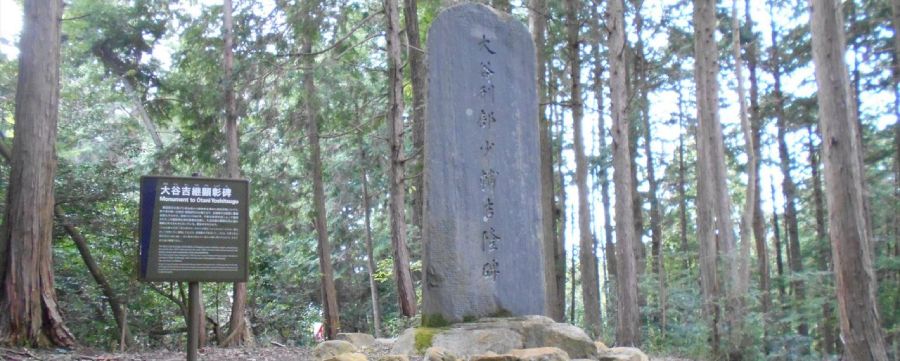
To the right of Yoshitsugu’s tomb is that of Otani Yoshitaka, perhaps another name for his son Yoshikatsu, who fought in the Battle of Sekigahara and also committed suicide after losing to Ieyasu’s forces. (L’writing on the stone monuments in the photograph identifies the tomb of Yuasa Gosuke and Otani Yoshitaka.
Although no name can be detected on the central stone monument, it is assumed to be Yoshitsugu’s because it is in the foreground and reflects the relationship between Yoshitsugu and two others). A radical variant of Gosuke protecting Yoshitsugu’s head from detection is also known; in this version, he decapitates himself to divert attention to his master’s remains.
Legacy and Popular Culture
Whether a hero or not, Yoshitsugu continues to be celebrated for his samurai spirit and loyalty to his duties. His tragic end against monstrous odds is one of the many folk tales of Sekigahara.
- Yoshitsugu is one of the Western army units in the strategy video game Kessen.
- Yoshitsugu is the inspiration for the fictional Lord Onoshi in James Clavell’s novel Shōgun.
- Yoshitsugu becomes a playable character in Samurai Warriors 4, using the saihai as a weapon. This incarnation is presented as a servant of Azai, as well as a close friend of Todo Takatora before Sekigahara. In contrast to most incarnations, Yoshitsugu is able to walk and run on his own although he hides his face and most of his body.
- In Sengoku Collection, Yoshitsugu is a girl plagued by bad luck, often spending her nights alone looking for clots on all fours.
- Yoshitsugu also appears in Sengoku Basara 3 as an enigmatic Western army strategist. He is also Motonari’s servant, as well as Mitsunari’s voice of reason. His goal in the game is to make all the other warriors suffer as much as he does.
- Yoshitsugu also introduces the fictional game Nioh as a general command force against Kobayakawa Hideaki. In the Battle of Sekigahara, he is depicted as a samurai hiding behind a white hood that covers his face except for his eyes. This version of Yoshitsugu is not blind and is armed with daishō (double katanas). After Kobayakawa’s betrayal, he uses antagonist Kelley’s magic to transform himself into a demon and fight on the front lines of battle. He is then defeated in a fight with protagonist William, one of the factors leading to Ishida’s defeat.
